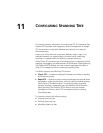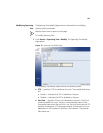11
CONFIGURING SPANNING TREE
This section contains information for configuring STP. The Spanning Tree
Protocol (STP) provides tree topography for any arrangement of bridges.
STP also provides a single path between end stations on a network,
eliminating loops.
Loops occur when alternate routes exist between hosts. Loops in an
extended network can cause bridges to forward traffic indefinitely,
resulting in increased traffic and reducing network efficiency.
While Classic STP prevents Layer 2 forwarding loops in a general network
topology, convergence can take between 30-60 seconds. Rapid Spanning
Tree Protocol (RSTP) detects and uses network topologies that allow a
faster STP convergence without creating forwarding loops.
The device supports the following STP versions:
■ Classic STP — Provides a single path between end stations, avoiding
and eliminating loops.
■ Rapid STP — Detects and uses network topologies that provide faster
convergence of the spanning tree, without creating forwarding loops.
While Classic STP prevents Layer 2 forwarding loops in a general
network topology, convergence can take between 30-60 seconds.
Rapid Spanning Tree Protocol (RSTP) detects and uses network
topologies that allow a faster STP convergence without creating
forwarding loops.
This section contains the following topics:
■ Viewing Spanning Tree
■ Defining Spanning Tree
■ Modifying Spanning Tree


















